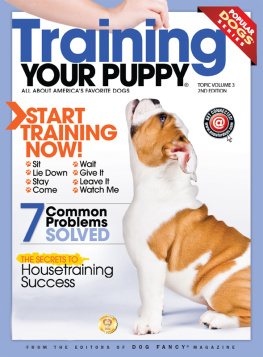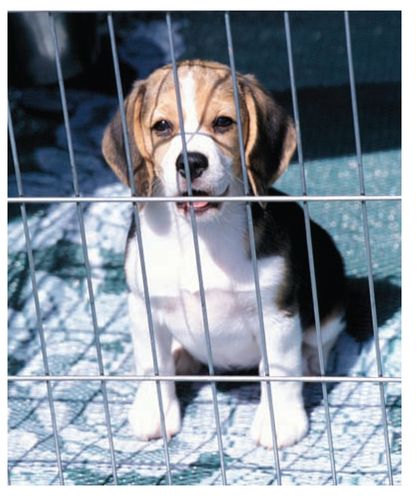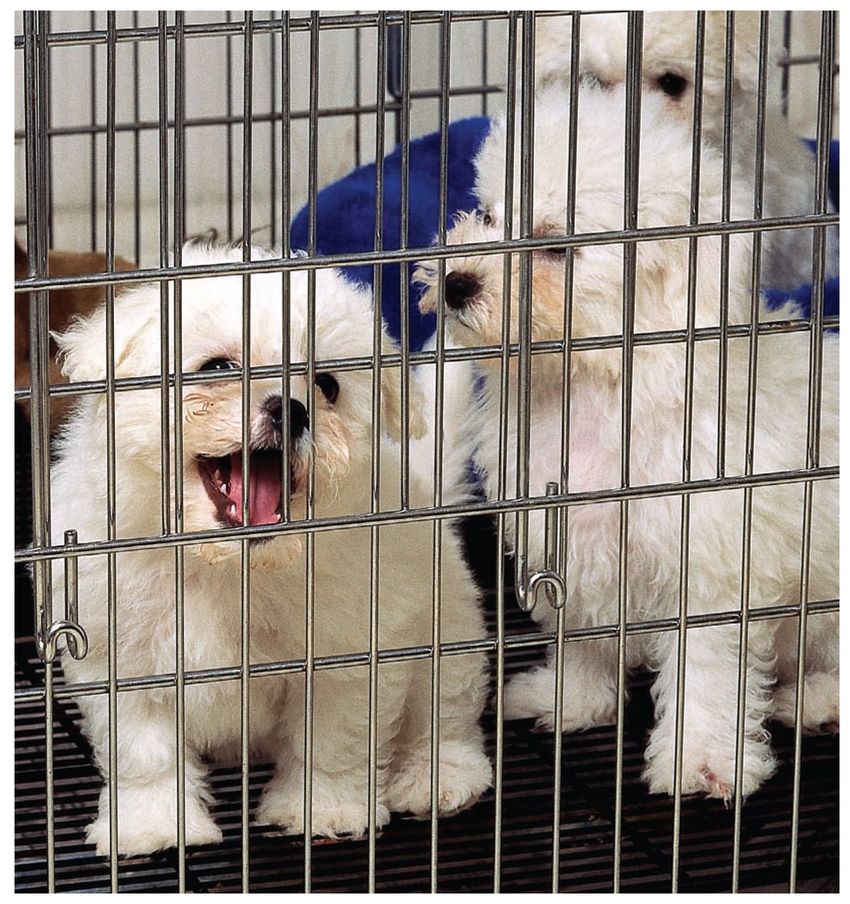CHAPTER 1
SETTING THE STAGE
When pups are about 3 weeks old and just beginning to wobble about and venture from their mothers, they instinctively walk away from their sleeping areas to relieve themselves. You might say that pups are naturally housetrained.
So when you bring your puppy home for the first time, youll need to take over where Mother Nature leaves off. Your first step in housetraining will be to teach your puppy to relieve himself only in approved areas. Then, your duties will consist of teaching your pup the acceptable doggie behavior in and around your house: what areas are off limits, how to react to strangers at the door, how to interact with young children, etc.
To achieve your housetraining goals, you must be rigidly consistent, alert and patient because even when your puppys bladder has matured enough to hold it a little longer between potty trips, you must not think of him as housetrained. Your pup still has a lot more to learn.
There are several approaches to the initial phase of housetraining. Stick with whichever method you choose, so that your pup wont get confused and you wont become frustrated. Remember, too, that success de pends not only on the age of your puppy but also on your level of experience with dogs, the type of home in which you live (apartment, condo, single-family house, etc.), the layout of your home (multilevel or single floor), your daily routine, your work schedule and the other members of your family.
Cleaning accidents properly with an enzyme solution will dramatically reduce the time it takes to housetrain your puppy because she wont be drawn back as easily to the same locations.
In simple terms, housetraining comes down to getting your puppy to the right place at the right time.
TIME AND SPACE
Your puppys age and where he came from will determine how quickly and easily he can be housetrained. Three-week-old pups instinctively want to keep their sleeping areas clean, but those instincts are stifled when humans step into the picture to prepare the pups to live with people.
An 8- to 10-week-old puppy from a responsible breeder, for example, may have had some initial cratetraining or exposure to a crate. He probably will be familiar with an exercise pen, as well, which he shared with his littermates.
Puppies of the same age that come from pet stores or shelters, however, are often more difficult to housetrain. Its not because the pups are less intelligent. Its simply because no one started training them, and they have had to relieve themselves wherever they happen to be. In pet stores, that means soiling their crates, which makes cratetraining at home more difficult. In shelters, there are generally far fewer very young puppies, and therefore older pups and dogs are usually kept in kennel stalls with concrete floors. The older ones may have the advantage of being taken for walks by volunteers several times a day, but thats physical exercise, not housetraining. Neither group of animals can be expected to understand our ideas of cleanliness. Even though they can definitely be housetrained (barring the existence of a medical problem), its easy to understand why it will take longer and require a lot more patience.
Ongoing housetraining difficulties may indicate your puppy has a healthproblem, warranting a veterinary checkup. A urinary infection, parasites, a virus or other nasty issues can greatly affect a puppys ability to hold her pee or poop.
Where you get your puppy will also determine how much information you have about him. You know that a pup from a responsible breeder has been at the breeders kennel since birth. A pup (or an older dog) from a shelter usually comes to you with little or no information about his previous life, partly depending on whether he was relinquished by his previous owners or picked up as a stray.
Dogs end up in shelters for countless reasons; not all shelter dogs were neglected or mistreated. Shelter-dog owners shouldnt use that as an excuse for their dogs misbehavior or difficulty in training. They just need a positive outlook to get their pets going in the right direction. Regardless of a shelter dogs actual age, begin housetraining an older dog as you would an 8- to 10-week-old puppy, until you and the dog are better acquainted and can begin to understand each other. It may take more time and more patience on your part.
RESCUE RESOURCES
Most breed clubs have their own rescue programs, whereby knowledgeable breed experts put adoptable dogs through an evaluation process to ensure that each dog goes to the best home. Finding the right adoption fit early on hopefully reduces the likelihood of the dog returning through a rescue revolving door. When they are picked up for rescue, these dogs are first checked by a veterinarian and spayed or neutered thereafter (or before being adopted, at the latest).
If you dont live close enough to go home during your lunch breaks or if you need to work overtime,
make alternative arrangements for letting your pup take her potty breaks. Hire a pet sitter, contact a petwalking service or enlist the aid of an obliging neighbor.
Most breed-rescue groups arrange for new dogs to live in foster homes for a while before they are adopted out, so that a knowledgeable person can evaluate the nature and extent of previous training (if any); the dogs temperament; his reactions to other dogs, cats and kids; and the dogs housetraining status.
Before adopting them out, most breed rescue groups foster incoming dogs, to discern their temperaments.
Groups that rescue dogs of all breeds and mixed breeds also perform general evaluations. Even if little is known about the dogs when they are taken in, these rescue volunteers and foster families try to learn all they possibly can about the dogs while readying them for adoption, so that they can inform potential owners of their findings.
FEAR FACTOR
Beware of the fear phase, which affects older puppies between 4 and 6 months of age. During this time, puppies shy away from or seem to be frightened by perfectly normal sights or sounds that they have never reacted to before. If you get a puppy of this age (or when your puppy reaches this stage), do not coddle or try to soothe him. Never pick him up to cuddle and comfort him or coo at him, saying things like, Poor little dog, its OK. Those actions only tell your pup that its acceptable to be shy or frightened and that you approve of his reactions.




















